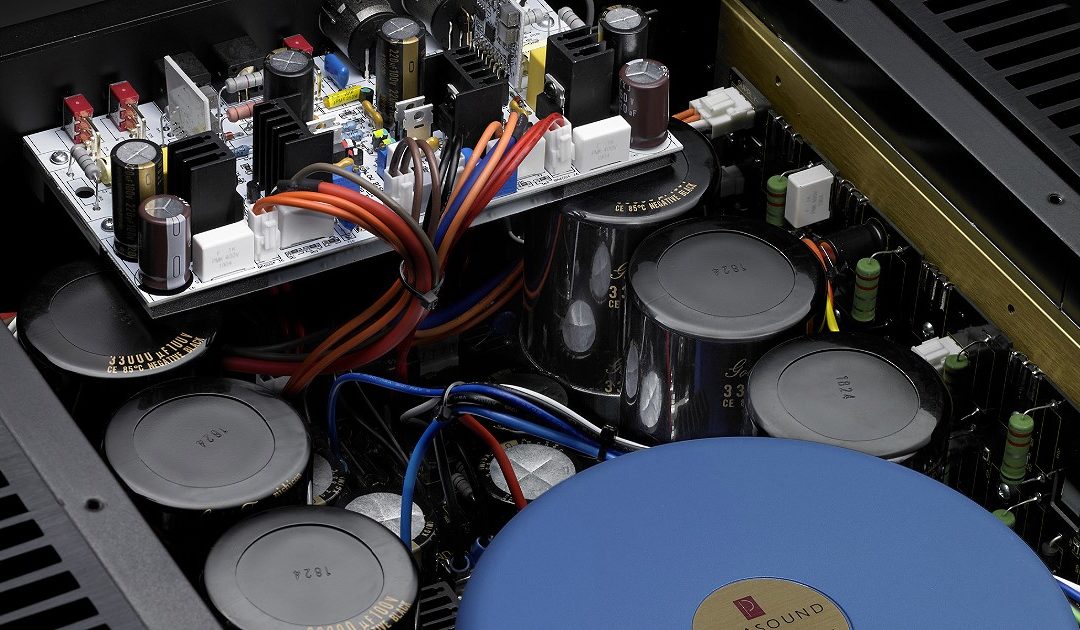In a Nutshell
Parasound has long been admired for their preamplifiers and power amplifiers. The JC 1+ power amplifier monoblock is their latest achievement, and it truly is an achievement to the highest degree. It has enough power (450 watts RMS into 8 Ohms) to drive any speaker, and the parts quality is a statement on its own. The sound is exemplary. At $16,990 for a pair, they are not cheap, but this kind of quality never is.
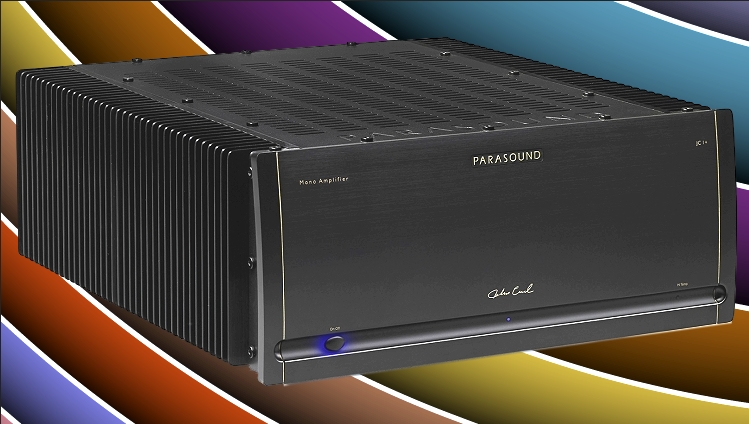
Highlights
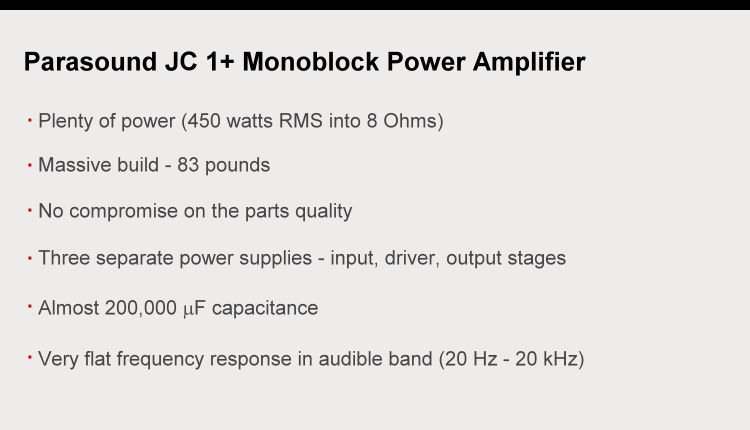
When Parasound released their JC 1 monoblock power amplifier in 2002, the A/V world was very impressed. No one felt they could ever be more impressed with one of their amplifiers, but the release of the JC 1+ monoblock changed that thinking.
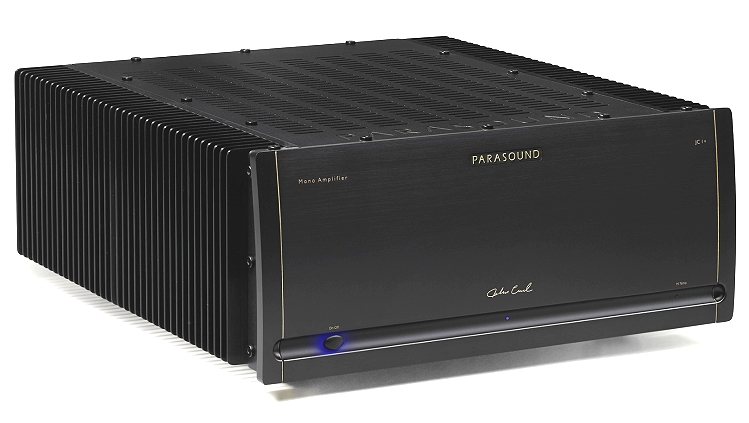
You can choose between a black chassis or silver. I chose black.
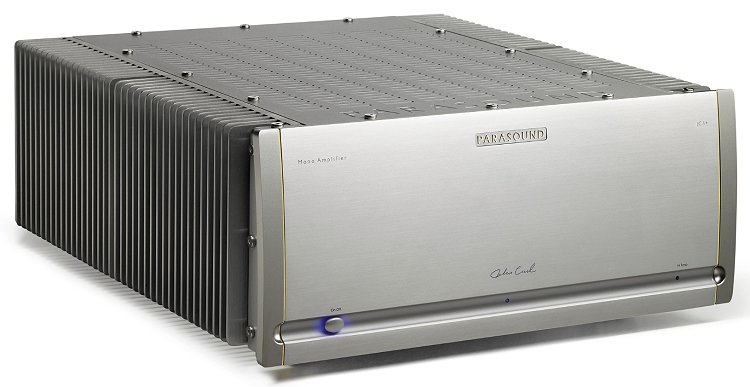
Introduction
Parasound, builder of preamplifiers and power amplifiers, was started in 1981 by Richard Schram, in San Francisco, California. They celebrate their 40th year, next year, in 2021.
In that time, Parasound has established itself as a quality manufacturer.
The JC 1 was powerful, at 400 watts RMS into 8 Ohms. The JC 1+ is even more powerful, at 450 watts. Power supply capacitance increased from 132,000 µF to 198,000 µF (that is 1/5th of a Farad). The power supply transformer is now 2.1 kVA (2,100 watts), which is important when you consider that, at 2 Ohms, the JC 1+ can deliver 1,200 watts (if you have them both plugged into the same 20 ampere 120 V AC circuit, it may trigger the circuit breaker – now that’s my kind of power).
PARASOUND JC 1+ POWER AMPLIFIER SPECIFICATIONS
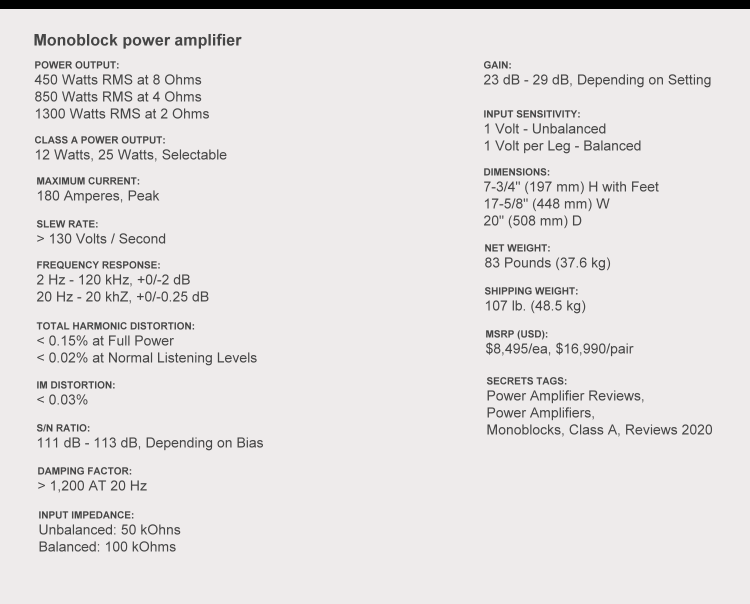
Website: http://www.parasound.com
Design
The Parasound JC 1+ power amplifier leaves no stone unturned in quality of parts. Toshiba JFETs for the input stage, Sanken bipolar transistors for the output stage, Nichicon Gold Tune power supply capacitors totaling 198,000 µF, a 30 pound 2,100 watt power supply transformer, a special circuit board substrate that delivers better propagation of high frequencies compared to Delrin, etc. The list goes on and on.
Here is a photo of the inside of the chassis:
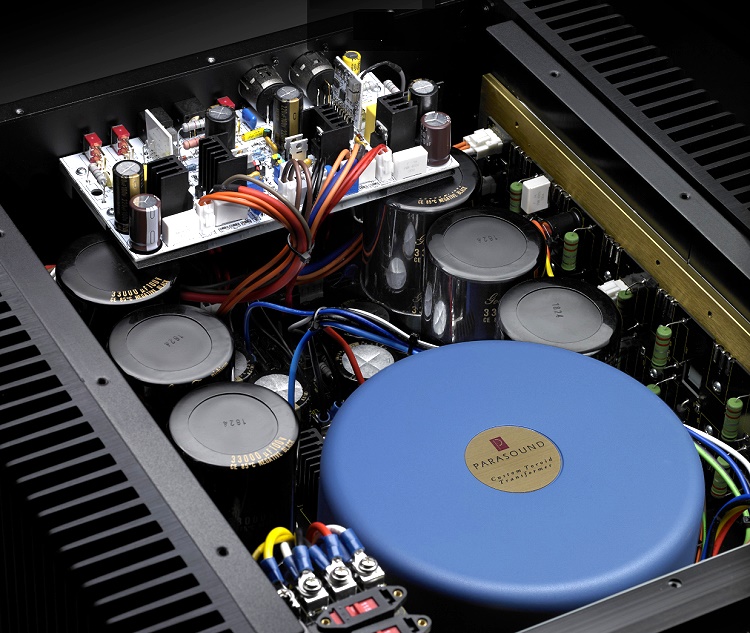
Look how big the heat sinks are. And they get hot too, as does the top of the chassis!
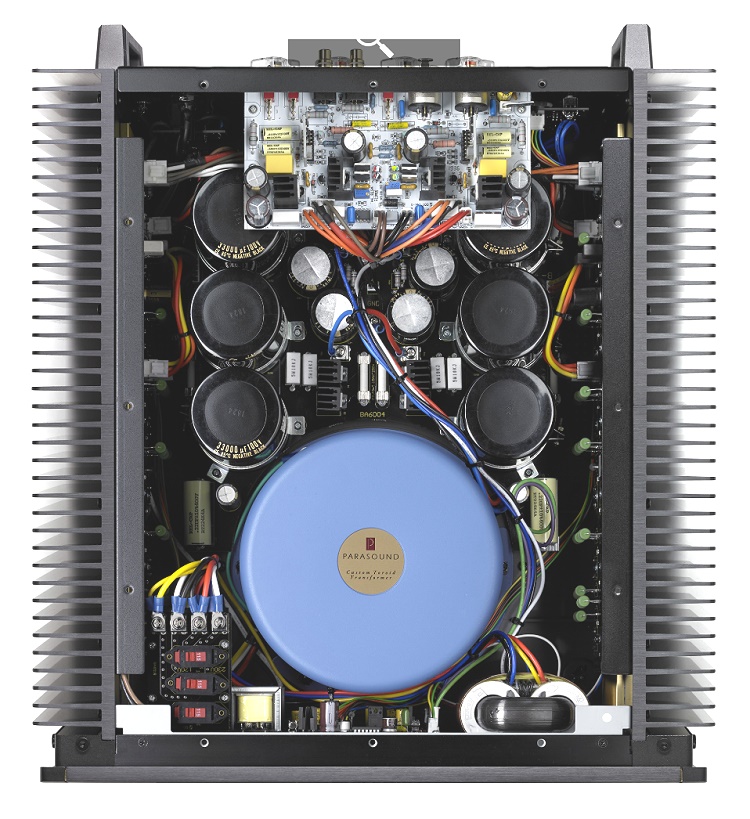
The rear panel has myriad selections, inputs, and outputs.
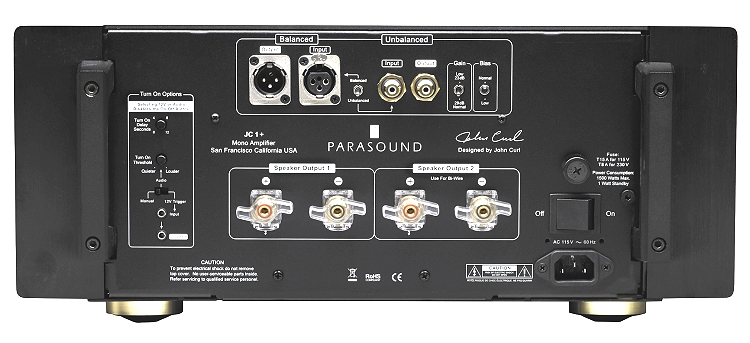
You can choose RCA or XLR inputs, pass-through an input to a second amplifier such as a subwoofer, time the power-on (Turn On Options) so that not all the amplifiers are turned on at exactly the same time (to keep from blowing a fuse in your circuit breaker), select lower gain to reduce noise, select lower Class A bias for more power, and activate the auto-on trigger which powers on the amplifier when it receives a preamplifier signal.
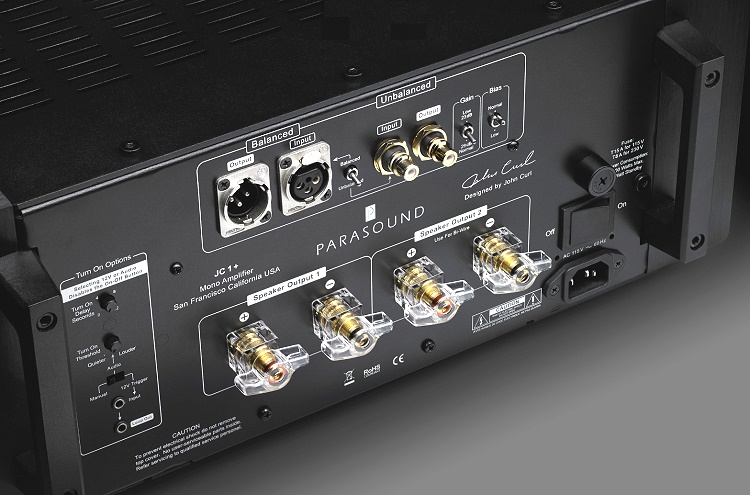
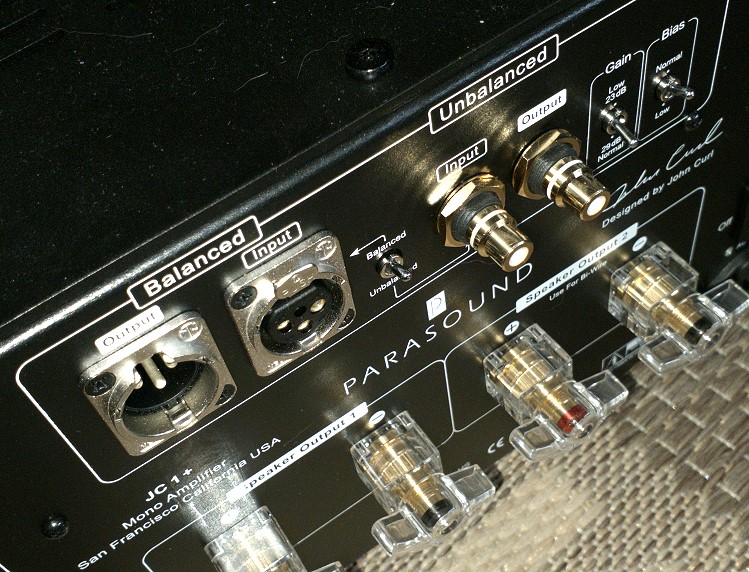
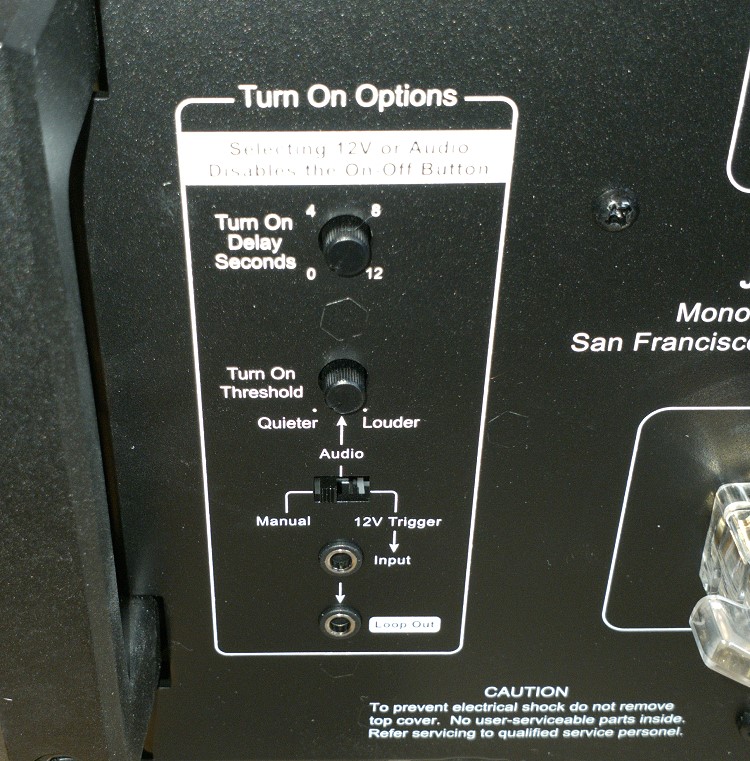
In Use
I listened to a pair of the Parasound JC 1+ power amplifiers with a computer (PC) delivering Tidal music streaming via USB input to an OPPO UDP-205 Universal Player, a hard drive connected to the UDP-205 with my entire digital music collection stored on it, VPI-HR-X Turntable with Sumiko Palo Santos MC Phono Cartridge, Manley Labs Steelhead Phono Preamplifier, Pass Labs Xs Preamplifier, Sonus faber Lilium Speakers, Wireworld XLR cables, and Clarus Crimson speaker cables. I used a Clarus Concerto Power Conditioner for the computer, OPPO UDP-205, and Pass Labs Xs Preamplifier. There is no power conditioner out there that will handle the 2,600 watt potential of the two JC 1+ power amps, especially when the computer, universal player, and preamplifier are also plugged into it.
Complete List of Reference Components: OPPO BDP-105 Universal Player (4), OPPO UDP-205 Universal Player (2), VPI-HR-X Turntable with Sumiko Blackbird MC Cartridge and Sumiko Palo Santos MC Cartridge, Manley Labs Steelhead Tube Phono Preamplifier (2), Balanced Audio Technology VK-5i Pure Class A Triode (Tube) Stereo Preamplifier (Fully Balanced), Balanced Audio Technology VK-500 Solid State Stereo Power Amplifier (Fully Balanced) (250 Watts per Channel), Pass Labs Xs Preamplifier, Pass Labs Xs 300 Monoblock Power Amplifiers (2) (300 Watts/each), Lamm LL1 Signature Stereo Pure Class A Triode (Tube) Preamplifier, MartinLogan CLX Full-Range Electrostatic Speakers, Magnepan 20.7 Planar-Magnetic Speakers, Paradigm Reference Signature SUB 2 Subwoofers (2), Custom-Built Computer for Audio Analysis, Accupel HDG-3000 Digital Color Signal Generator (1080i capable), Component Video and DVI Output, ColorFacts Pro Video Test and Calibration Software, Version 6.0, Spyder Sensor, SpectraPlus Audio Analysis Software, Audio Precision SYS-2722 Spectrum Analyzer, Staco 3PN2210B-DVM 22 Ampere Variable Transformer (for adjusting line voltage to 120 volts during amplifier power output tests), Pass Labs XP-20 Stereo Preamplifier, Classé SSP-800 Surround Sound Processor, Emotiva XMC-1 Surround Sound Processor, Classé CA-5200 Five-Channel Power Amplifier (200 Watts per Channel), Pass Labs X600.8 Power Amplifiers (4) (600 Watts/Each), Audio Control Phase Coupled Activator (Sub-Harmonic Generator), Carver Platinum Mark IV Ribbon Speakers, MartinLogan Summit X Hybrid Electrostatic Speakers (2) (Rear Left/Right), MartinLogan Stage X Hybrid Electrostatic Speakers (3) (Center and Sides Left/Right), Velodyne DD-18+ Subwoofer (3), HiFiMAN HE1000 Planar Magnetic Headphones, OPPO PM-1 Planar Magnetic Headphones, OPPO HA-1 Headphone Amplifier, Bryston BUC-1 USB Converter, Sony VPL-HW55ES 1,920 x 1,080p Digital Projector, 90″ (Diagonal) Stewart Grayhawk Projection Screen, Sony 75″ UHD Flat Panel Display, Clarus Audio and Wireworld cables, Clarus Concerto Power Conditioner with Crimson Power Cable.
Music – Tidal – Beethoven Violin Sonatas Nos. 4,5, and 8 – James Ehnes, James Armstrong – Onyx – Released 4/24/2020
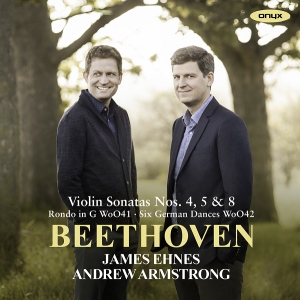
Violins are difficult instruments to reproduce because they are mostly very high frequencies, and this is where a lot of distortion can occur. But, the Parasound JC 1+ power amplifiers did their thing without audible distortion. They had a very clean sound without harshness. That is very important to a relaxing music listening experience.
Music – Tidal – Chopin Impromptus and Scherzos – Mao Fujita – Piano – Naxos – Released 10/16/2019
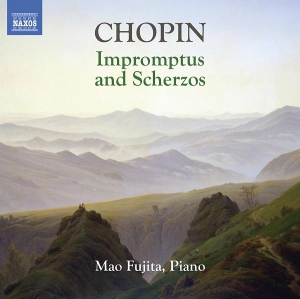
Piano is another difficult instrument to reproduce, but not because of a prevalence of distortion. It is because there are many notes that are being played at the same time, perhaps 10 because there are 10 fingers on two hands. This makes for a complex waveform.
Impromptu is self explanatory.
A Scherzo is a light composition, frequently the third movement of a symphony, sonata, or string quartet; also, in the Baroque era (c. 1600–c. 1750), a light vocal or instrumental piece (e.g., the Scherzi musicali of Claudio Monteverdi, 1607), and, in the 19th century, an independent orchestral composition (https://www.britannica.com/art/scherzo).
These Chopin masterpieces (did he ever compose something that wasn’t?) are reproduced as such by the JC 1+. Dynamic, clarity, detail. Yes.
Music – Tidal – Art Blakey & the Jazz Messengers – The Finest – Blue Note, Universal – Released 4/3/2020

Art Blakey & the Jazz Messengers were a jazz combo from the classic jazz period of the mid 20th century.
This album has Lee Morgan on trumpet, Benny Golson on tenor sax, Bobby Timmons on piano, and Art Blakey on drums. All of these musicians were stars in their own right.
Most of the tracks were remastered in 1998, 1999, and 2005. Some were digitally remastered, and this is probably because the master analog tapes were in poor condition. But, better to have them go through a digital intermediate than not to have them at all.
I continue to be amazed at how good the tracks from 60 year-old analog tapes sound. This is due to excellence in recording, careful remastering, and, of course, having a good audio system to listen with. The Parasound JC 1+ power amplifiers are up to the task here. The overall sound is warm, almost tube-like, which I find very, very pleasant.
The bass in this album is intense. That, I think, is because analog tape often had a bass bump between 50 Hz and 100 Hz. This brought out some deep “presence” that is appealing.
Music – Tidal – Julio Iglesias – Mexico – Released 5/8/2020

What I listen for with singing is that the sound maintains separation between the instruments and the voice. The Parasound JC 1+ amplifiers did very well with this. Julio has been around a long time, and I think he will be with us for a long time in the future too. This is as good an album as any for you to introduce yourself to his talent.
Music – The Beauty that Still Remains – 2L Norway – 2020

2L is world-renown for superb quality digital recordings. This new disc has their typical array of resolutions and formats, including 24/192 DTS HD MA, Dolby Atmos 7.0.4 48 kHz, Auro-3D 96 kHz, SACD, and 2-channel 24/192 PCM.
It has the Schola Sanctae Sunnivae Girls’ Choir from Trondheim, founded in 1992. In this case, I wanted to be able to discern individual voices of the girls, among the background music. Again, the Parasound JC 1+ amplifiers distinguished themselves. Track 21 is particularly gorgeous.
Here is the choir with the recording setup in a cathedral.
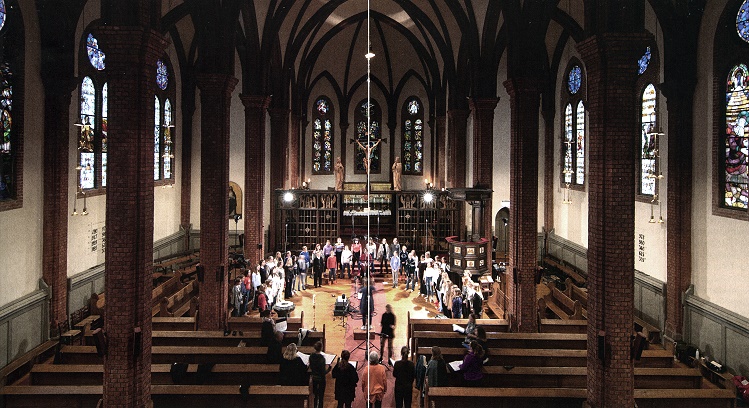
The disc is dedicated to Anne Frank, the 16 year old Jewish girl who was born in Frankfurt, Germany in 1929 and died in the Bergen-Belsen concentration camp in Germany in 1945.
One of the most important of the Parasound’s capabilities is in dynamics. Its very high power (450 watts into 8 ohms) delivers a tremendous dynamic range. So, it is not just the ability to drive any speaker on the planet. It will allow very quiet passages and very loud passages as well, without having to change the volume control.
Parasound states that they use Nichicon Gold Tune capacitors for the power supply, and that although these capacitors are no longer generally available, Parasound has an exclusive contract with Nichicon to continue supplying these caps to them. I found a review of the sound of various capacitors, and indeed, the Gold Tune caps sounded better than others. That was back in 2015. I imagine there are new capacitors that sound as good, but I don’t blame Parasound with sticking to what works for them.
MY LATEST EXPERIENCE WITH CABLES
I recently tried some generic speaker cable. The cable became defective and shorted out my power amplifier. Fortunately, the power amp had a protection circuit. I decided that I would never use such cable again.
I have several sets of audiophile-grade cable that I have used over the years, and I obtained a set of Clarus Crimson speaker cable. One leg is 8 feet long, and the other is 20 feet. My setup required the long cable for the right channel. I didn’t want to have the left channel the same length (20 feet) which would have necessitated coiling it up behind the speaker. That would have produced induction (like a transformer coil). I know that it theoretically would be best to have the left and right channel speaker cables the same length.
Below is a photo of the 20 foot cable. It is very heavy and built like the proverbial tank. This 20 foot cable by itself is $4,000 retail price. I know, I know, that is a lot of money for a speaker cable, but it sure is not going to short out and pop my power amplifier protection circuit.
Clarus cables are built in the USA rather than overseas.
I measured the impedance of the 20 foot cable, and it was 35 mOhm (milli-ohms) at 1 kHz, which is very low. For audio systems where the source and amplifier stack are in between the speakers, you would probably be using two of the 6 foot cables, at about $4,000 for the pair. The impedance is 6/20 that of the 20 foot cable, which is 10.5 mOhm (10.5 thousandths of an Ohm). I use banana plugs because I have to make changes easily when I am reviewing speakers. I would suggest that you get the cables with spade connectors for a more permanent attachment.
![]()
Here is the cable attached to a Sonus faber Lilium speaker. The other end was connected to the Parasound JC 1+ power amplifier.
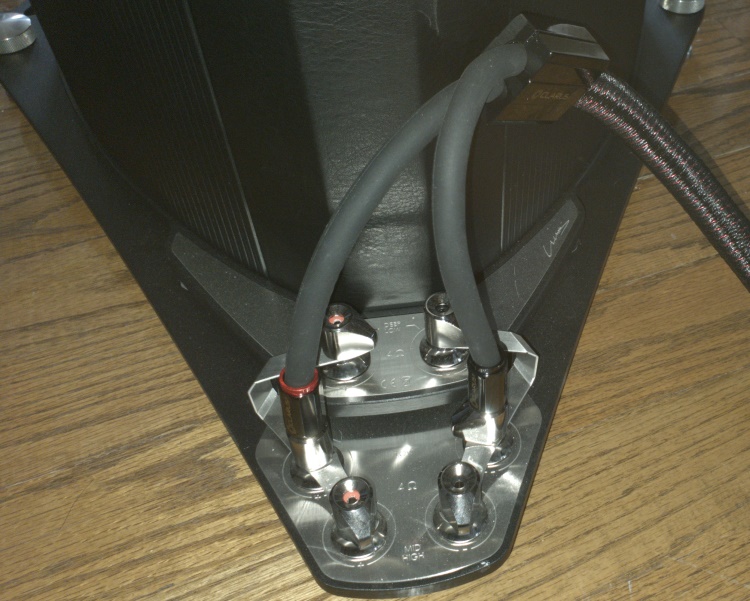
Note that such cables are for high-end products (amplifiers and speakers). If you have relatively inexpensive mass-market receiver and speakers, then such cables would not be appropriate. In this case, I would recommend getting a 50 foot or 100 foot roll of 12 gauge stranded speaker cable from Monoprice (https://www.monoprice.com/product?p_id=2747) and some banana plugs (https://www.monoprice.com/product?p_id=9436) or spade connectors (https://www.amazon.com/Insulated-U-Type-Connector-Electrical-Terminal/dp/B07PG1NCQZ/ref=sr_1_18?dchild=1&keywords=spade+connectors&qid=1589736054&sr=8-18) (you will have to solder spade lugs to the cable). Cut the cable length so that you can go from the rear of the receiver down to the floor, along the floor, and up to the speaker binding posts.
Although a home-made cable like this will have higher impedance than the Clarus Crimson or other high-end cables, they will be fine for mass market products. You will need a wire stripper, and in the case of the spade lugs, a soldering iron with some solder. For the banana plugs, strip about ½” of the end of each conductor and twist the strands before unscrewing the banana plug and inserting the stripped conductor, and then retightening the plug. Keep track of using the red banana plug for one side (either + or -) for both ends of the cable. Usually, the speaker binding posts on the rear of the receivers and speakers will have red and black posts.
If you want something that is ready to go (for mass market receivers), and not generic, then consider something like these (https://www.audioadvisor.com/prodinfo.asp?number=AQT8NF&opt=1176|1189|1196|1201), or these (https://www.audioadvisor.com/prodinfo.asp?number=KK4TC&opt=6440|392|398|404) for the front left and right channels.
Clarus also has a lower priced line of cables called Aqua, which are about half the price of the Crimson. They are similar to Crimson but have smaller conductors. These would work well for lower powered, high-end amplifiers (e.g., 50 – 100 watts RMS into 8 Ohms) such as Pure Class A tube products.
I asked Clarus to explain the reason for the high price. Here is their answer:
The patented design and construction of Clarus Cables are unique requiring sophisticated engineering and manufacturing equipment. The raw wire used for making speaker, audio, and power cables are made with conductors that are extruded into special shapes using the highest grade of ultra-pure copper available. One of the special shapes is the spiral ribbon conductor. It has PE fiber as the core and thin copper foil wrapped spirally around the core using special non-typical machinery. The foil is made from round conductors that are flattened between rollers, then run through an extrusion line to add the insulation. Then, all the conductors are run individually through an extrusion line to add the PE insulation that covers every conductor. All of these special conductors then go through precision twisting machines before going through another extrusion line to add the outer jacket. The sub-assemblies are then twisted together, or else held in fixtures in the case of flat cables, to provide the plus and minus conductors. In the case of the bi-wire cables, all four sets of conductors go through an extrusion line to add the final outer jacket. Next, a braiding machine braids the outer woven jacket onto the cable. The many complex and time-consuming steps require a considerable amount of labor. The overall construction is atypical and extremely expensive to do. There are no generic components used in the construction of Clarus Cables.
In the evaluation of costs, it is also necessary to consider the thousands of hours of R&D involved to perfect the final cable geometry as well as the initial tooling costs. Each part of the cable design including the connectors, breakouts, silicon tubing, and cabling required expensive tooling. Every part of a Clarus Cable is unique – there are no off-the-shelf components in the manufacturing.
The cost of Clarus cables also should be considered relative to other cables. For instance, many other high-end cables, which cost much less than Clarus to manufacture, can cost the consumer many multiples of Clarus yet not sound as good. As such, Clarus Cables represent an excellent value for consumers wishing to improve their system’s performance.
Looking at the complexity of these cables, I can see why they are expensive. All the components are made in their own facility using custom-designed extruding machines. It’s not the same as purchasing transistors, capacitors, resistors, and other parts that are already manufactured.
Anyway, I am convinced that it is worth the high price to get something that is built for an audiophile system in every stage of the signal path, including the cables. Out of all the components, it is very unlikely that anyone would ever need to replace them with another model or brand. Good for life, I think. And, I don’t have to worry about cheap cables shorting out my power amplifiers that cost tens of thousands of dollars.
So, that is what I did. I am waiting for the new Crimson RCA and XLR cables that will be available in the first quarter of 2021.
BACK TO THE JC 1+
On the Bench
Gain and Bias were set to Normal (29 dB Gain, 25 Watts Class A Bias).
At 1 kHz and 5 Volts into 8 Ohms. Distortion plus noise was 0.0066%.
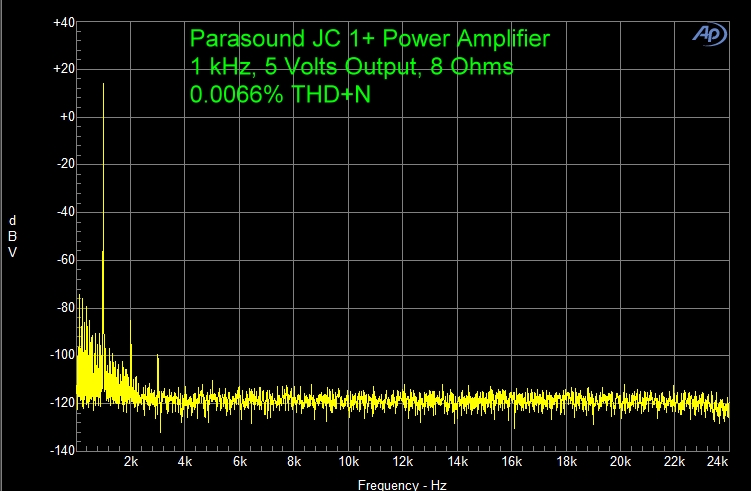
At 4 Ohms, distortion was a tiny bit higher. Still insignificant.

Twenty Volts output into 8 Ohms (50 watts). Distortion plus noise was still quite low. Observable harmonics went out to 17th order. The 2nd ordered harmonic was 10 dB higher than the 3rd.
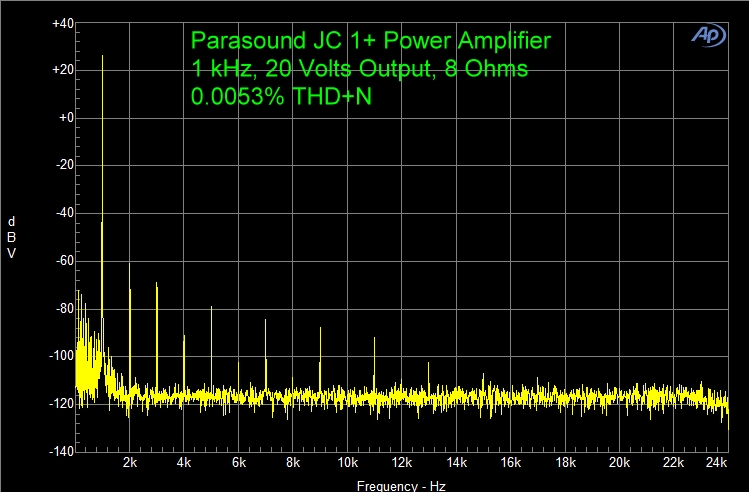
At 4 Ohms, distortion plus noise was still less than 0.01%. The difference between the 2nd ordered harmonic and the 3rd was reduced to about 5 dB.
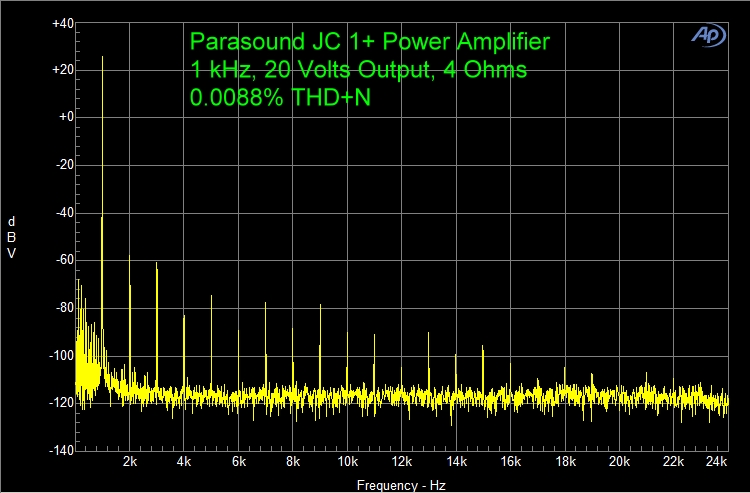
Using 19 kHz and 20 kHz sine waves at 5 Volts into 8 Ohms, there were two visible peaks on either side of the fundamentals.
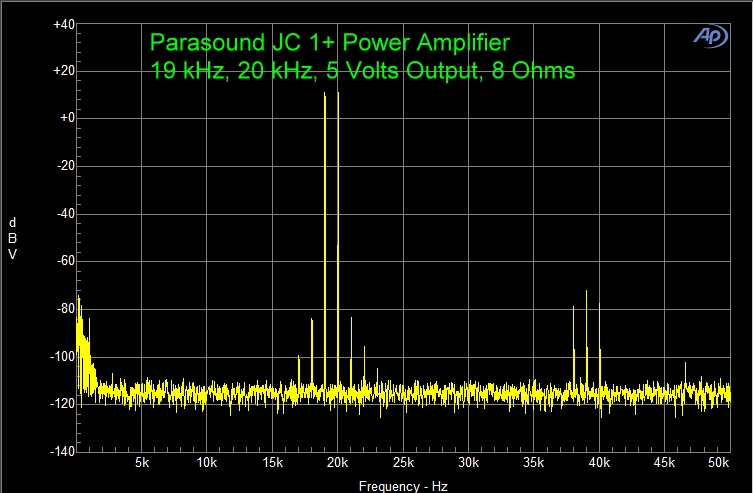
At 4 Ohms, the number of peaks was increased by two on either side of the fundamentals.
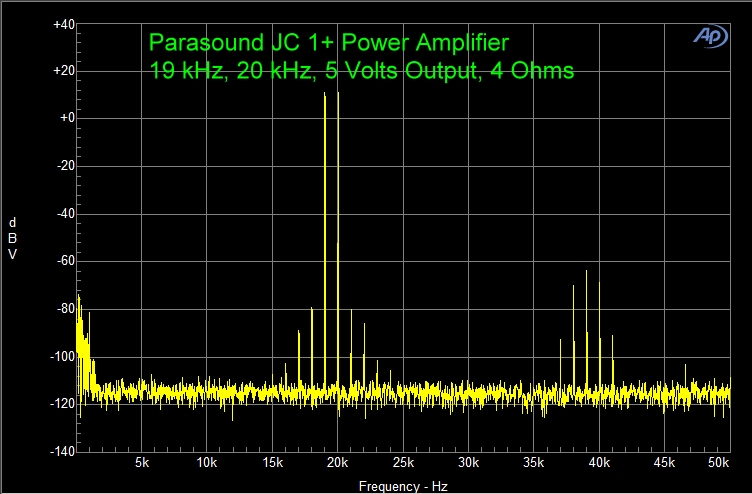
Increasing the output to 20 Volts produced seven peaks on either side, at 8 Ohms.
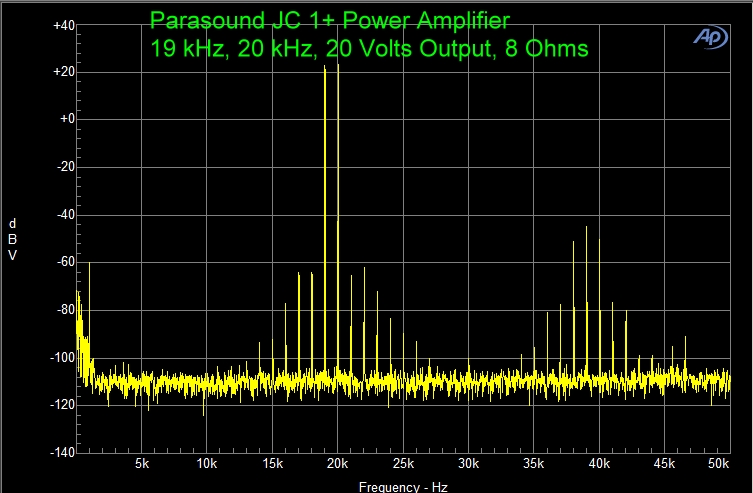
Using 4 Ohms impedance at 20 Volts, there were nine side peaks on the right side, and they were higher.
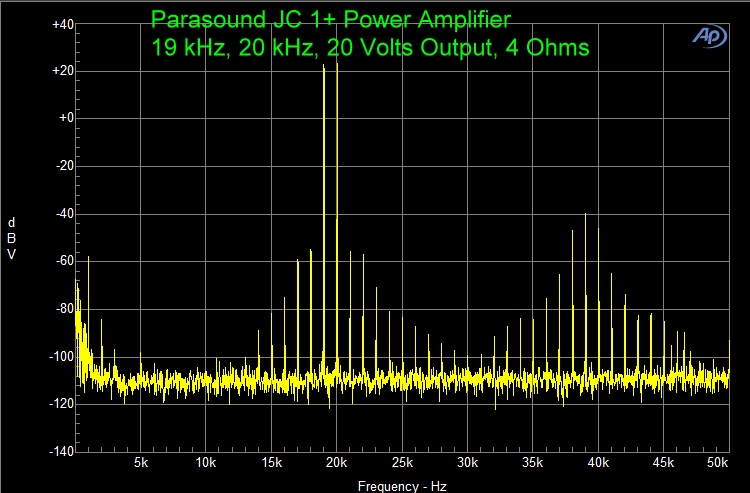
The B-A peak at 1 kHz, 20 Volts, 4 Ohms, 19 kHz and 20 kHz sine waves. It is a little more than 70 dB lower than the signal peaks. There are harmonics of the B-A peak at 2 kHz, 3 kHz, and 5 kHz.
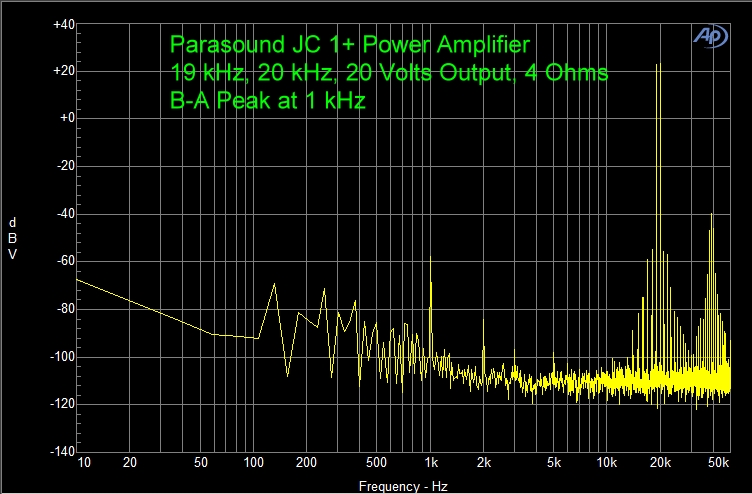
The B-A peak with 8 Ohms impedance is 3 dB lower than at 4 Ohms (about 73 dB lower than the signal peaks). There are also no harmonics of the B-A peak at 2 kHz, 3 kHz, or 5 kHz.

IMD at 5 Volts output into 8 Ohms was 0.0049%.
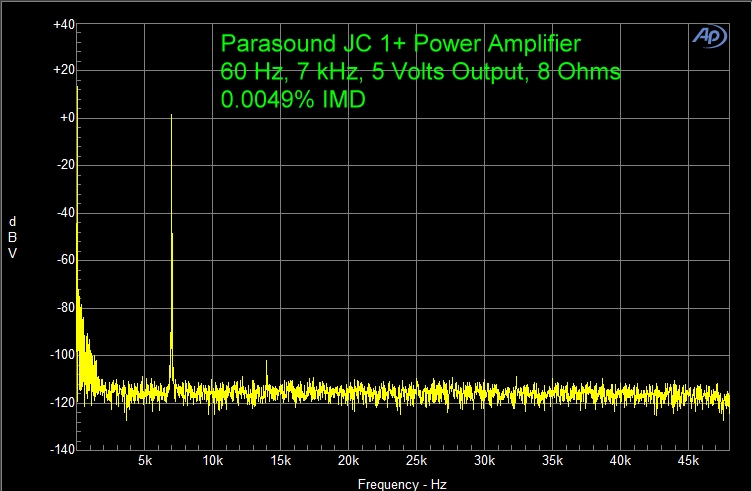
Five Volts into 4 Ohms, IMD was 0.0074%.
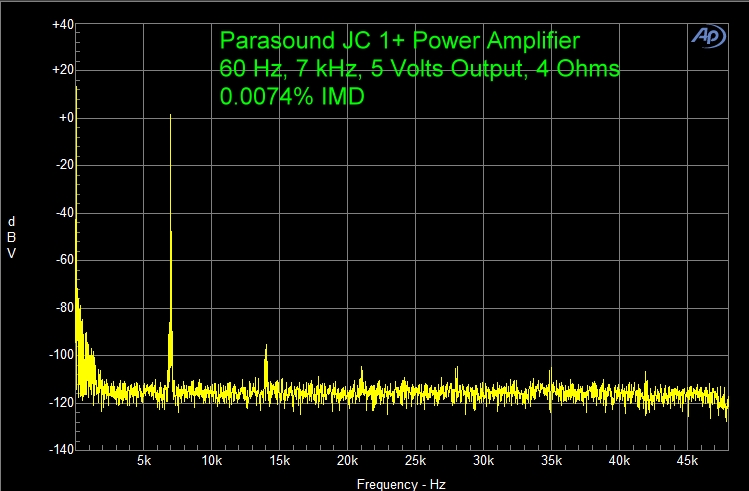
At 20 Volts, 8 Ohms, IMD increased to 0.0204%.
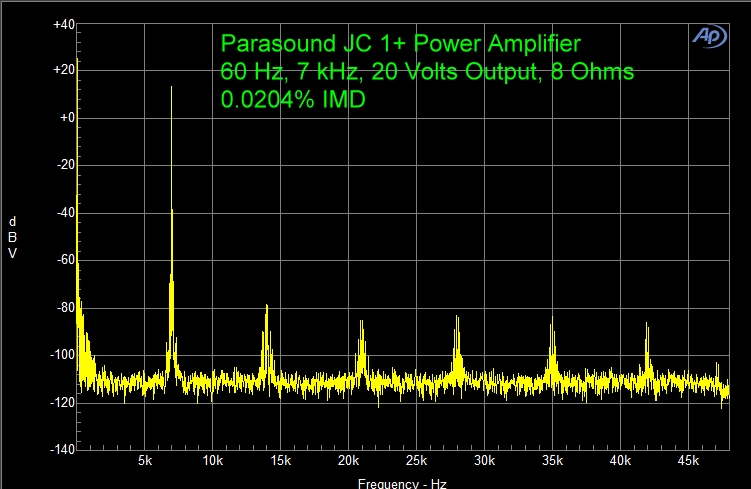
And 20 Volts at 4 Ohms . . .
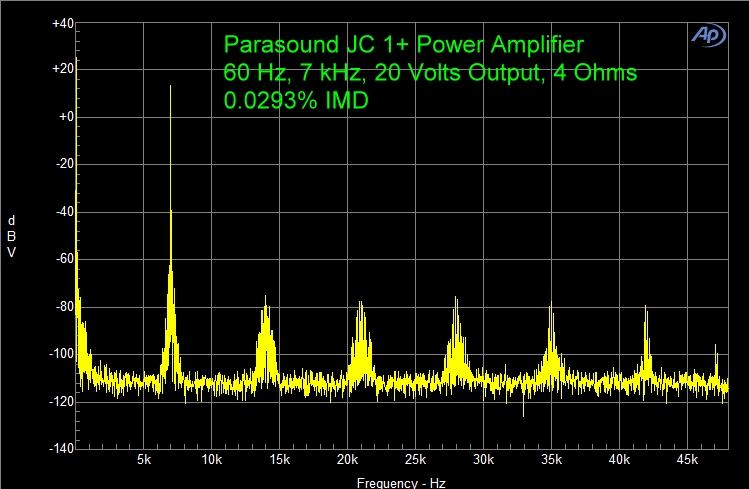
The frequency response is down 0.2 dB at 20 kHz, on spec. It is pretty much the same at 8 Ohms and 4 Ohms.

THD+N vs. Frequency, 5 Volts and 20 Volts output, is shown below, at 8 Ohms load.
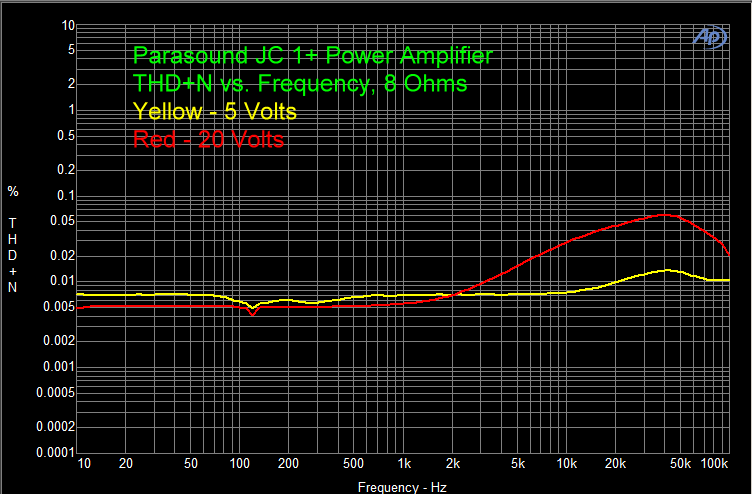
At 4 Ohms. Distortion is a few hundredths of a percent higher. Distortion goes down at high frequencies (above 40 kHz) because the number of harmonics that the amplifier can pass is also reduced.
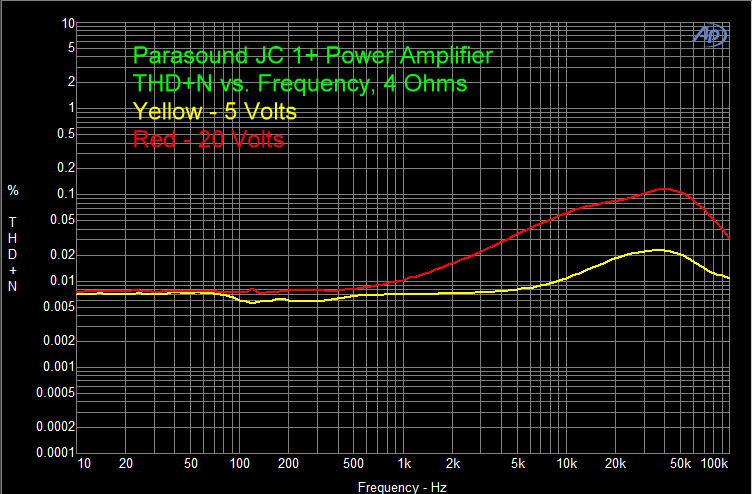
THD+N vs. Power Output, at 8 Ohms, is shown below. It clips (1%) at 450 Watts RMS. Right on spec. This test uses 1 kHz.

At 4 Ohms, clipping occurred at 710 Watts. This is because the amplifier was getting hot. It does show that if you listen to music pretty loud with a 4 Ohm speaker, the power limit from the amplifier will decrease as the amplifier heats up. That is normal. There is also voltage sag that occurs with 120 VAC wall socket supplies during high current demand. This is not the Parasound’s fault.
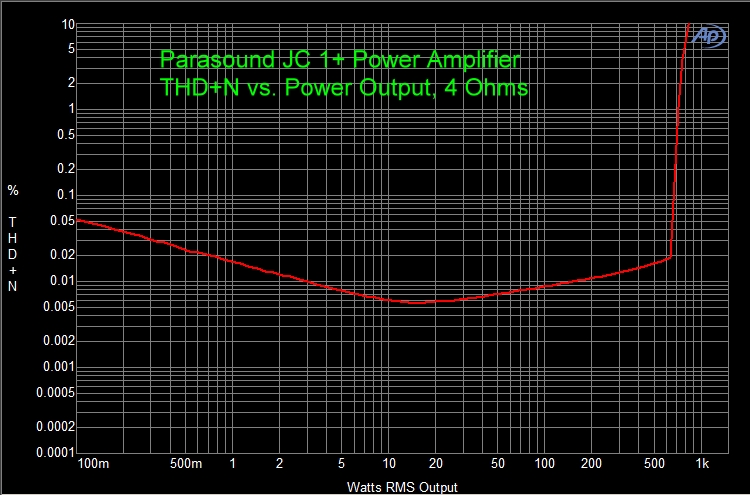
Using 10 kHz and 4 Ohms, distortion was higher overall, and clipping was at 760 Watts.
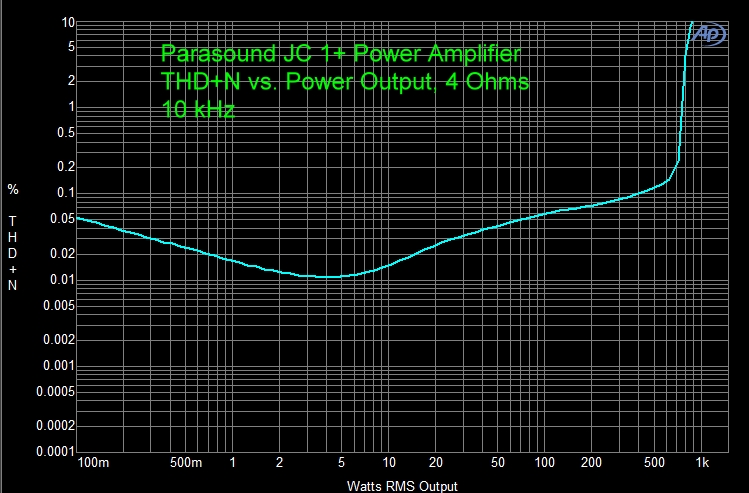
At 20 kHz and 4 Ohms, distortion was higher overall yet, with clipping at 790 Watts.
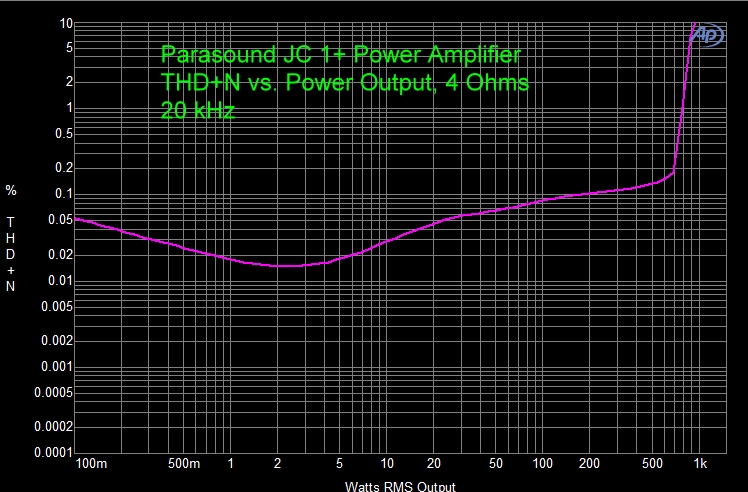
And at 20 Hz, clipping was at 730 Watts.
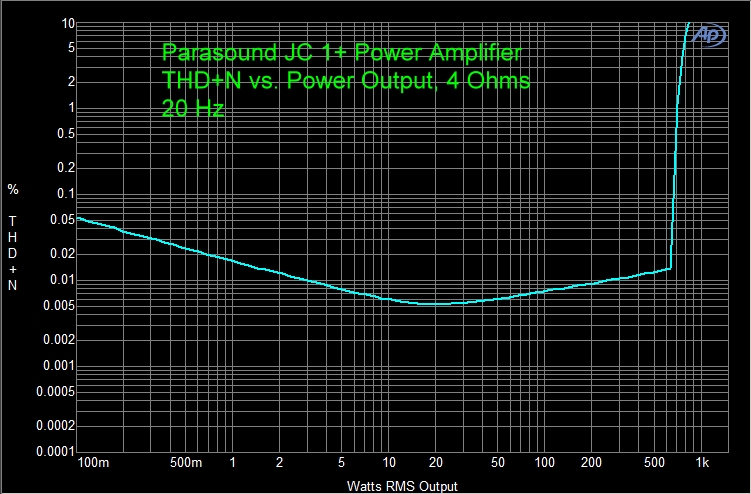
So, this is an interesting new set of tests (THD+N vs. Power at different frequencies). THD+N vs. Power Output usually is tested only with a 1 kHz sine wave. We will see how various amplifiers perform with these tests as time goes along.
Conclusions
The Parasound JC 1+ Power Amplifiers are very high quality. One would expect that from the almost $17,000/pair price, but high price is no guarantee of quality for any product. It has to be verified. Proof of Performance for the Parasound has been verified. They are worth the price.
Amplifiers are out there that cost a quarter of a million dollars.
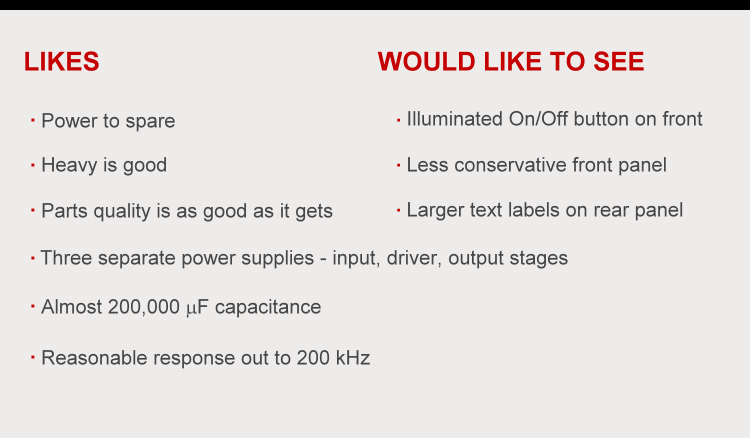
I asked Richard Schram some questions in general about the future of A/V, but also specifically about the JC 1+.
Hello John,
You have asked some interesting questions. My answers are below, in red.
- Now that hi-fi equipment has reached a level that is truly superb, what sort of improvements are left to pursue?
RS: I agree that we’ve reached a level that is truly superb. But that is realized primarily by people who have the means to spend vast amounts of money and are willing to live with the intrusion of very large speakers and bulky speaker wire, etc. The biggest improvement would be to secure the future of serious audio. It is a decades-old lament that our industry hasn’t found a way to make superb musical reproduction equipment compelling for young people. Many manufacturers don’t seem to care about this, or they aren’t aware that they are operating on borrowed time and are content with their present business model. Some will survive until the start-up money runs out.
- Will the latest transistor technology (stacked Nanosheet FETs) provide audible differences from conventional bipolar and Mosfet/JFet technology?
RS: John Curl and I recently discussed this, and we are gathering information. We will look into any emerging technology that has the potential of improving performance and offering a tangible benefit to listeners.
- Will Class D, G, H, and J amplifiers become the norm in receivers and power amplifiers compared to Class A and A/B?
RS: I am not familiar with Class J and found no mention in Wikipedia. So I asked John Curl and he called the brilliant microwave engineer in Silicon Valley with whom he co-invented Bybee Music Rails. He learned that “Class J” is for microwave frequencies in the gigahertz range. Their characteristics are undesirable for high quality audio frequency amplification.
Class G and H refer primarily to an amplifier’s power supply topology. Even though our NewClassic power amplifiers are superb examples of Class G, we mention only their Class AB audio circuit topology to avoid confusion. I think Class D has already won the war for a number of reasons. Resources of the larger companies that manufacture the component parts for Class D on a larger scale, the relative simplicity of manufacturing are cost effective because of the scale of the component manufacturers.
I am concerned about what I call the “over-democratization” of Class D. Anyone can purchase an excellent Class D module, slap on their “special” input stage and bring an amp to market. Since the core of these amps are the same how does one brand differentiate its amplifiers from another brand’s amplifiers using the same Class D module? We had some lively discussions within Parasound about this topic in the early stage of the JC 1+ development. One camp expressed interest in expediting a JC 1 replacement that would abandon Class AB by abandoning an enormous linear power supply and whatever R&D time was required for a 6 month development time and vastly lower cost by simply using Pascal* X-PRO1 modules. Jeff Rowland uses these modules in his $32,000 Daemon. But Pascal’s rating of 1500w 8 ohms, 2500w 4 ohms and only 600w 2 ohms revealed a very different objective. My position is different. How could we make a product that is “ours” and differentiate it from another brand? I felt the “keep it simpler” approach was inconsistent with our values and not sufficiently forward looking.
We like and respect Pascal’s products and staff. Our well-regarded and popular NewClassic 200 Integrated amplifier uses a Pascal module and has received extensive critical acclaim.
A “hidden cost” of continuing to build high quality Class AB amplifiers is the paucity of component parts. Every year more audio-grade component parts are discontinued because the volumes are too small and inconvenient for component parts manufacturers. This poses a real challenge to our supply chain management. Our frugality enables Parasound to purchase large quantities of superior parts, unmatched by present parts, that were discontinued long ago.
- There are thousands of Blu-ray discs (2K), but just a few hundred 4K movie discs even though 4K has been here for several years, so 4K has had only limited success. Now that 8K flat panel TVs are here, will they be a passing fad or will they become the norm, which includes significant content?
RS: I haven’t paid enough attention to video to have an informed opinion.
- Since vinyl has a definite resurgence, will there be an increased amount of new analog tape recordings rather than just depending on old tape masters from the 1950’s and 1960’s?
RS: I can’t imagine it breaking out of its present niche. There are is no economy of scale for tape recordings, rebuilt tape decks are hard to find and prohibitively expensive and there isn’t sufficient possibility of a return on investment for any audio manufacturer to design and manufacture tape decks. You might recall the stylish floor-standing Revox tape deck announced in 2017, then cancelled because it wouldn’t make economic sense for them.
We remain committed to vinyl. We anticipated its continuing growth and developed two new phono preamps in the past two years.
- Is there any new surround sound format coming?
RS: I don’t have sufficient familiarity to answer this since we discontinued production of our Halo C 1 and C 2 surround processors. Our business model is based on building products in which we invest heavily in R&D, with the expectation that they will remain in continuous production for many years. We don’t fix what isn’t broken. With the exception of hand-milled aluminum panel end caps and replacing the illuminated P logo with an embossed logo, the JC 1+ 4 rack space chassis is the same as the JC 1 chassis which was designed in 2001 and tooled in 2002.
I believe the primary purpose for developing and marketing an amplifier is to honor its customers in every respect the money will follow. Approaching our 40th anniversary, Parasound proves this ideal. Products that are primarily silicon-based are, by definition, subject to constant changes because the enormous manufacturers of these parts must continually innovate with new features to justify higher prices and annual reports that will satisfy their shareholders. That’s their business model. It’s not ours.
- You mention that the JC 1+ uses a cascode driver circuit because it has higher input impedance and higher output impedance. I had thought that lower output impedance is best. Can you clarify?
RS: The manufacture of FETs is a totally different process than bi-polar devices. FETs are, in fact, high impedance devices which are superior for voltage amplification. This is largely because their harmonic characteristics tend to be even-ordered, emulating this characteristic of vacuum tubes. The output stage supplies current, for which John Curl specifies bi-polar devices. He believes they are superior to MOSFETs even though it is much easier to design a MOSFET output stage than a bi-polar output stage because bi-polar devices require more complex protection circuitry.
Perhaps lower output impedance only applies to the output stage output impedance. See above
- What made you decide to design a power amplifier with no compromises of any kind?
RS: The JC 1 was warmly received and enjoyed a very long and illustrious product life. When it was designed in 2000, and for many subsequent years, it was the best power amp we could build while staying within the practical boundaries that define all of our products: “We believe most Parasound customers aren’t independently wealthy.” Our unwavering commitment to Value Engineering continues to differentiate Parasound from other brands.
When, in 2014, Curl identified new opportunities for improvements that didn’t exist when the JC 1 was designed years ago, I considered it my responsibility to again build the best amplifier I could. This part of my job brings me enormous pleasure and satisfaction. While the JC 1+ is our most expensive product, it is also our greatest value, given its extraordinary performance/price ratio. The JC 1+ embodies our highest achievement of value engineering and my greatest sense of accomplishment.
Kind regards,
Richard
